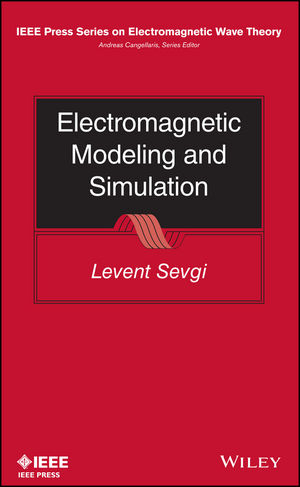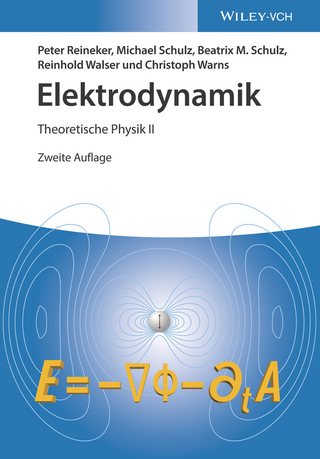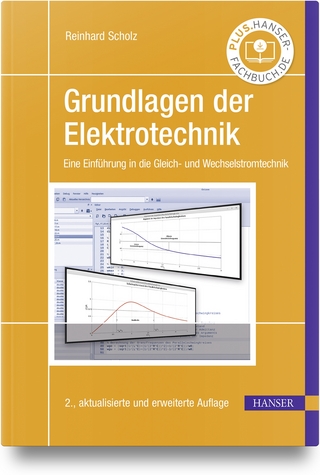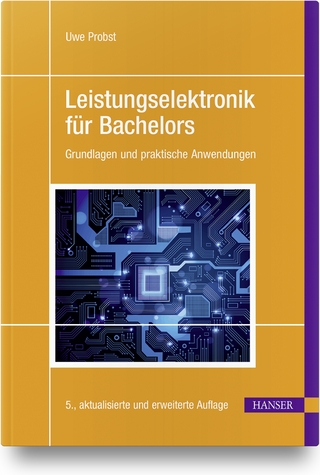
Electromagnetic Modeling and Simulation
Wiley-IEEE Press (Verlag)
978-1-118-71618-2 (ISBN)
This unique book presents simple, easy-to-use, but effective short codes as well as virtual tools that can be used by electrical, electronic, communication, and computer engineers in a broad range of electrical engineering problems
Electromagnetic modeling is essential to the design and modeling of antenna, radar, satellite, medical imaging, and other applications. In this book, author Levent Sevgi explains techniques for solving real-time complex physical problems using MATLAB-based short scripts and comprehensive virtual tools.
Unique in coverage and tutorial approach, Electromagnetic Modeling and Simulation covers fundamental analytical and numerical models that are widely used in teaching, research, and engineering designs—including mode and ray summation approaches with the canonical 2D nonpenetrable parallel plate waveguide as well as FDTD, MoM, and SSPE scripts. The book also establishes an intelligent balance among the essentials of EM MODSIM: The Problem (the physics), The Theory and Models (mathematical background and analytical solutions), and The Simulations (code developing plus validation, verification, and calibration).
Classroom tested in graduate-level and short courses, Electromagnetic Modeling and Simulation:
Clarifies concepts through numerous worked problems and quizzes provided throughout the book
Features valuable MATLAB-based, user-friendly, effective engineering and research virtual design tools
Includes sample scenarios and video clips recorded during characteristic simulations that visually impact learning—available on wiley.com
Provides readers with their first steps in EM MODSIM as well as tools for medium and high-level code developers and users
Electromagnetic Modeling and Simulation thoroughly covers the physics, mathematical background, analytical solutions, and code development of electromagnetic modeling, making it an ideal resource for electrical engineers and researchers.
LEVENT SEVGI, BSEE, MSEE, PhD, works at the Electronics and Communication Engineering Department at Dogus University in Istanbul, while serving as a full-time faculty member at University of Massachusetts, Lowell (UML) during his sabbatical. A former chair of the Electronic Systems Department in TUBITAK-MRC, Information Technologies Research Institute, Dr. Sevgi is also the author or coauthor of nearly 200 journal, magazine, conference papers, and tutorials; a Fellow of the IEEE; AdCom Member of the IEEE Antennas and Propagation Society (AP-S; 2013-2015); the writer/editor of the “Testing Ourselves” column in the IEEE Antennas and Propagation Magazine; and a member of the IEEE AP-S Education Committee.
Preface xvii About the Author xxvii
Acknowledgments xxix
1 Introduction to MODSIM 1
1.1 Models and Modeling, 2
1.2 Validation, Verifi cation, and Calibration, 5
1.3 Available Core Models, 7
1.4 Model Selection Criteria, 9
1.5 Graduate Level EM MODSIM Course, 11
1.5.1 Course Description and Plan, 11
1.5.2 Available Virtual EM Tools, 12
1.6 EM-MODSIM Lecture Flow, 12
1.7 Two Level EM Guided Wave Lecture, 17
1.8 Conclusions, 19
References, 19
2 Engineers Speak with Numbers 23
2.1 Introduction, 23
2.2 Measurement, Calculation, and Error Analysis, 24
2.3 Significant Digits, Truncation, and Round-Off Errors, 27
2.4 Error Propagation, 28
2.5 Error and Confi dence Level, 29
2.5.1 Predicting the Population’s Confidence Interval, 33
2.6 Hypothesis Testing, 36
2.6.1 Testing Population Mean, 38
2.6.2 Testing Population Proportion, 39
2.6.3 Testing Two Population Averages, 39
2.6.4 Testing Two Population Proportions, 39
2.6.5 Testing Paired Data, 40
2.7 Hypothetical Tests on Cell Phones, 41
2.8 Conclusions, 45
References, 45
3 Numerical Analysis in Electromagnetics 47
3.1 Taylor’s Expansion and Numerical Differentiation, 47
3.1.1 Taylor’s Expansion and Ordinary Differential Equations, 50
3.1.2 Poisson and Laplace Equations, 52
3.1.3 An Iterative (Finite-Difference) Solution, 53
3.2 Numerical Integration, 58
3.2.1 Rectangular Method, 58
3.3 Nonlinear Equations and Root Search, 62
3.4 Linear Systems of Equations, 64
References, 69
4 Fourier Transform and Fourier Series 71
4.1 Introduction, 71
4.2 Fourier Transform, 72
4.2.1 Fourier Transform (FT), 72
4.2.2 Discrete Fourier Transform (DFT), 74
4.2.3 Fast Fourier Transform (FFT), 76
4.2.4 Aliasing, Spectral Leakage, and Scalloping Loss, 77
4.2.5 Windowing and Window Functions, 80
4.3 Basic Discretization Requirements, 81
4.4 Fourier Series Representation, 85
4.5 Rectangular Pulse and Its Harmonics, 92
4.6 Conclusions, 92
References, 94
5 Stochastic Modeling in Electromagnetics 95
5.1 Introduction, 95
5.2 Radar Signal Environment, 98
5.2.1 Random Number Generation, 98
5.2.2 Noise Generation, 101
5.2.3 Signal Generation, 108
5.2.4 Clutter Generation, 108
5.3 Total Radar Signal, 111
5.4 Decision Making and Detection, 114
5.4.1 Hypothesis Operating Characteristics (HOCs), 115
5.4.2 A Communication/Radar Receiver, 119
5.5 Conclusions, 129
References, 130
6 Electromagnetic Theory: Basic Review 133
6.1 Maxwell Equations and Reduction, 133
6.2 Waveguiding Structures, 134
6.3 Radiation Problems and Vector Potentials, 136
6.4 The Delta Dirac Function, 138
6.5 Coordinate Systems and Basic Operators, 139
6.6 The Point Source Representation, 141
6.7 Field Representation of a Point/Line Source, 142
6.8 Alternative Field Representations, 143
6.9 Transverse Electric/Magnetic Fields, 145
6.9.1 The 3D TE/TM Waves, 145
6.9.2 The 2D TE/TM Waves, 146
6.10 The TE/TM Source Injection, 151
6.11 Second-Order EM Differential Equations, 154
6.12 EM Wave–Transmission Line Analogy, 155
6.13 Time Dependence in Maxwell Equations, 157
6.14 Physical Fundamentals, 158
References, 158
7 Sturm–Liouville Equation: The Bridge between Eigenvalue and Green’s Function Problems 161
7.1 Introduction, 161
7.2 Guided Wave Scenarios, 162
7.3 The Sturm–Liouville Equation, 165
7.3.1 The Eigenvalue Problem, 167
7.3.2 The Green’s Function (GF) Problem, 168
7.3.3 Finite z-Domain Problem, 169
7.3.4 Infi nite z-Domain Problem, 170
7.3.5 Relation between Eigenvalue and Green’s Function Problems, 171
7.4 Conclusions, 172
References, 173
8 The 2D Nonpenetrable Parallel Plate Waveguide 175
8.1 Introduction, 176
8.2 Propagation Inside a 2D-PEC Parallel Plate Waveguide, 177
8.2.1 Formulation of the TE- and TM-Type Problems, 178
8.2.2 The Green’s Function Problem, 181
8.2.3 Accessing the Spectral Domain: Separation of Variables, 182
8.2.4 Spectral Representations: Eigenvalue Problems, 183
8.2.5 Spectral Representations: 1D Characteristic Green’s Functions, 184
8.2.6 The 2D Green’s Function Problem: Alternative Representations, 185
8.3 Alternative Representation: Eigenray Solution, 187
8.3.1 Relation between Eigenmode and Eigenray Representations, 191
8.3.2 2D GF and Hybrid Ray-Mode Decomposition, 192
8.4 A 2D-PEC Parallel Plate Waveguide Simulator, 194
8.4.1 Representations Used for Mode, Ray, and Hybrid Solutions, 195
8.4.2 MATLAB Packages: RayMode and Hybrid, 207
8.4.3 Numerical Examples, 210
8.5 Eigenvalue Extraction from Propagation Characteristics, 215
8.5.1 Longitudinal Correlation Function, 215
8.5.2 Numerical Illustrations, 217
8.6 Tilted Beam Excitation, 221
8.7 Conclusions, 223
References, 225
9 Wedge Waveguide with Nonpenetrable Boundaries 227
9.1 Introduction, 228
9.2 Statement of the Problem: Physical Configuration and Ray-Asymptotic Guided Wave Schematizations, 229
9.3 Source-Free Solutions, 230
9.3.1 Separable Coordinates: Conventional NM, 230
9.3.2 Weakly Nonseparable Coordinates: AM, 231
9.3.3 Uniformizing the AM Near Caustics: IM, 232
9.4 Test Problem: The 2D Line-Source-Excited Nonpenetrable Wedge Waveguide, 234
9.4.1 Exact Solution in Cylindrical Coordinate, 234
9.4.2 Approximate Solutions in Rectangular Coordinates, 241
9.4.3 IM Spectral Representation, 244
9.5 The MATLAB Package “WedgeGUIDE,” 247
9.6 Numerical Tests and Illustrations, 249
9.7 Conclusions, 256
Appendix 9A: Formation of the Spectral IM Integral in Section 9.3.3, 257
References, 262
10 High Frequency Asymptotics: The 2D Wedge Diffraction Problem 265
10.1 Introduction, 266
10.2 Plane Wave Illumination and HFA Models, 268
10.2.1 Exact Solution by Series Summation, 268
10.2.2 The Physical Optics (PO) Solution, 270
10.2.3 The PTD Solution, 272
10.2.4 The UTD Solution, 273
10.2.5 The Parabolic Equation (PE) Solution, 275
10.3 HFA Models under Line Source (LS) Excitations, 275
10.3.1 Exact Solution by Series Summation, 276
10.3.2 Exact Solution by Integral, 277
10.3.3 The Parabolic Equation (PE) Solution, 277
10.4 Basic MATLAB Scripts, 278
10.5 The WedgeGUI Virtual Tool and Some Examples, 291
10.6 Conclusions, 297
References, 298
11 Antennas: Isotropic Radiators and Beam Forming/Beam Steering 301
11.1 Introduction, 301
11.2 Arrays of Isotropic Radiators, 303
11.3 The ARRAY Package, 306
11.4 Beam Forming/Steering Examples, 310
11.5 Conclusions, 317
References, 318
12 Simple Propagation Models and Ray Solutions 319
12.1 Introduction, 320
12.2 Ray-Tracing Approaches, 321
12.3 A Ray-Shooting MATLAB Package, 323
12.4 Characteristic Examples, 329
12.5 Flat-Earth Problem and 2Ray Model, 333
12.6 Knife-Edge Problem and 4Ray Model, 338
12.7 Ray Plus Diffraction Models, 348
12.8 Conclusions, 351
References, 351
13 Method of Moments 353
13.1 Introduction, 353
13.2 Approximating a Periodic Function by Other Functions: Fourier Series Representation, 354
13.3 Introduction to the MoM, 359
13.4 Simple Applications of MoM, 361
13.4.1 An Ordinary Differential Equation, 361
13.4.2 The Parallel Plate Capacitor, 364
13.4.3 Propagation over PEC Flat Earth, 366
13.5 MoM Applied to Radiation and Scattering Problems, 372
13.5.1 A Complex Antenna Structure, 372
13.5.2 Ground Wave Propagation Modeling, 373
13.5.3 EM Scattering from Infinitely Long Cylinder, 376
13.5.4 3D RCS Modeling, 381
13.6 MoM Applied to Wedge Diffraction Problem, 386
13.7 MoM Applied to Wedge Waveguide Problem, 397
13.8 Conclusions, 402
References, 402
14 Finite-Difference Time-Domain Method 407
14.1 FDTD Representation of EM Plane Waves, 407
14.1.1 Maxwell Equations and Plane Waves, 408
14.1.2 FDTD and Discretization, 410
14.1.3 A One-Dimensional FDTD MATLAB Script, 417
14.1.4 MATLAB-Based FDTD1D Package, 417
14.2 Transmission Lines and Time-Domain Reflectometer, 429
14.2.1 Transmission Line (TL) Theory, 430
14.2.2 Plane Wave–Transmission Line Analogy, 434
14.2.3 FDTD Representation of TL Equations, 437
14.2.4 MATLAB-Based TDRMeter Package, 447
14.2.5 Fourier Analysis and Reflection Characteristics, 454
14.2.6 Laplace Analysis and Fault Identification, 456
14.2.7 Step Response, 464
14.3 1D FDTD with Second-Order Differential Equations, 468
14.4 Two-Dimensional (2D) FDTD Modeling, 472
14.4.1 Field Components and FDTD Equations, 476
14.4.2 FDTD-Based Virtual Tool: MGL2D Package, 477
14.4.3 Characteristic Examples, 479
14.5 Canonical 2D Wedge Scattering Problem, 494
14.5.1 Problem Postulation, 494
14.5.2 Review of Analytical Models, 496
14.5.3 The FDTD Model, 499
14.5.4 Discretization and Dey–Mittra Approach, 502
14.5.5 The WedgeFDTD Package and Examples, 505
14.5.6 Wedge Diffraction and FDTD versus MoM, 510
14.6 Conclusions, 512
References, 512
15 Parabolic Equation Method 515
15.1 Introduction, 516
15.2 The Parabolic Equation (PE) Model, 518
15.3 The Split-Step Parabolic Equation (SSPE) Propagation Tool, 520
15.4 The Finite Element Method-Based PE Propagation Tool, 528
15.5 Atmospheric Refractivity Effects, 531
15.6 A 2D Surface Duct Scenario and Reference Solutions, 533
15.7 LINPE Algorithm and Canonical Tests/Comparisons, 538
15.8 The GrSSPE Package, 558
15.9 The Single-Knife-Edge Problem, 566
15.10 Accurate Source Modeling, 571
15.11 Dielectric Slab Waveguide, 580
15.11.1 Even and Odd Symmetric Solutions, 582
15.11.2 The SSPE Propagator and Eigenvalue Extraction, 584
15.11.3 The Matlab-Based DiSLAB Package, 585
15.12 Conclusions, 591
References, 591
16 Parallel Plate Waveguide Problem 595
16.1 Introduction, 595
16.2 Problem Postulation and Analytical Solutions: Revisited, 599
16.2.1 Green’s Function in Terms of Mode Summation, 602
16.2.2 Mode Summation for a Tilted/Directive Antenna, 604
16.2.3 Eigenray Representation, 606
16.2.4 Hybrid Ray + Image Method, 613
16.3 Numerical Models, 613
16.3.1 Split Step Parabolic Equation Model, 613
16.3.2 Finite-Difference Time-Domain Model, 617
16.3.3 Method of Moments (MoM), 622
16.4 Conclusions, 638
References, 639
Appendix A Introduction to MATLAB 643
Appendix B Suggested References 653
Appendix C Suggested Tutorials and Feature Articles 655
Index 659
| Erscheint lt. Verlag | 9.5.2014 |
|---|---|
| Reihe/Serie | IEEE/OUP Series on Electromagnetic Wave Theory |
| Sprache | englisch |
| Maße | 159 x 241 mm |
| Gewicht | 907 g |
| Themenwelt | Naturwissenschaften ► Physik / Astronomie ► Elektrodynamik |
| Technik ► Elektrotechnik / Energietechnik | |
| ISBN-10 | 1-118-71618-3 / 1118716183 |
| ISBN-13 | 978-1-118-71618-2 / 9781118716182 |
| Zustand | Neuware |
| Informationen gemäß Produktsicherheitsverordnung (GPSR) | |
| Haben Sie eine Frage zum Produkt? |
aus dem Bereich


